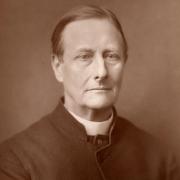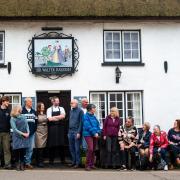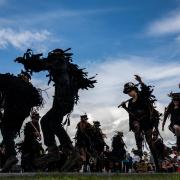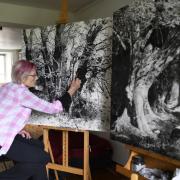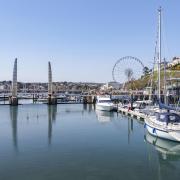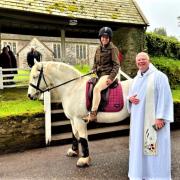This month sees the 475th anniversary of a series of historic events which took place in Devon during the summer of 1549.
The Western Rising of 1549 was a reaction to escalating religious reforms under the government of Edward VI including the introduction of a new prayer book, one which villagers in Sampford Courtenay refused to abide by. Protestors across Devon and Cornwall joined them and the resulting bloody rebellion led to what locals would call the ‘Commotion Time’.
It’s a slice of local history that has led to a new production created by Exeter’s Northcott Theatre which will be staged this autumn. The new play, The Commotion Time, was written by Sarah Dickenson, and focuses on the people of Poundstock, the village in North Cornwall where she grew up, who joined the protest and marched to Exeter.
The play is also significant in that it marks a return of professional, home-produced drama to the Northcott, and is being directed by its new creative director Martin Berry.
He says: 'The Commotion Time is a South-West story, by a South-West writer, that speaks directly to the people of Exeter, Cornwall and beyond. Most importantly it is rooted firmly in community, in every sense.’

A blood-drenched summer
Historian Mark Stoyle has been working with Sarah and the Northcott theatre team on The Commotion Time
The Western Rising of 1549 was the most catastrophic event to take place in Devon between the Black Death of the 1380s and the English Civil War. Thousands were killed during the fighting, and the events of the ‘Commotion time’ - as West Country folk referred to that blood-drenched summer - were remembered for centuries to come. The rebellion was essentially the result of conservative opposition to the English Reformation: the series of revolutionary religious changes which had recently been imposed upon the English people. Resentment had been building up ever since the 1530s, when Henry VIII had decided to break with the Catholic Church and establish a new form of worship. By the time Henry died, in 1547, and was succeeded by his son, Edward VI, discontent was rife. Edward was only nine and, with a child on the throne, government lay in the hands of the king’s councillors. This caused great unease among religious traditionalists, who feared that powerful men were forcing the new faith of Protestantism upon the young king. Sure enough, Edward’s government soon issued a new set of orders for religious reform. These were intended to sweep away all sorts of traditional practices and to move the Church much further towards full-on Protestantism.
In June 1549 the Crown ordered that every parish should adopt a new form of Prayer Book. Unsurprisingly, religious conservatives were alarmed, and after the inhabitants of the mid-Devon village of Sampford Courtenay had heard the new service, they decided that enough was enough. Led by a man named Underhill, they persuaded their vicar to abandon the new book and revert to the old service instead. Within days, many protesters had gathered at Sampford Courtenay. From here, they made their way to Crediton, where they were attacked by a group of local gentlemen, who killed several of them on the spot. This caused outrage among the country-folk and what had previously been a relatively modest protest turned into a full-scale rebellion. Towards the end of June, the rebels urged the people of Exeter to join them, but the town governors resolved to remain loyal to the Crown. The rebels therefore laid siege to the city. Meanwhile, the flame of insurrection had spread into Cornwall, and in July, thousands of Cornishmen arrived to assist the Devon rebels before Exeter.

The nobleman whom the government had ordered to suppress the disturbances - Lord Russell - did not dare to attack the rebels for some weeks. But in late July powerful reinforcements arrived in Russell’s camp, enabling him to defeat a rebel force which had advanced as far as Fenny Bridges, near Honiton. Soon afterwards, the royal commander moved over to the offensive: marching towards Exeter with his army, and defeating the rebels in a savage battle fought at Clyst Heath on 5 August. That night, the surviving insurgents stole away from their positions around Exeter and abandoned the siege. When Russell’s troops finally appeared before the city, early the next day, there was great rejoicing among the citizens and 6 August - ‘Jesus Day’, as it was known - would be kept as an annual day of thanksgiving in Exeter for centuries to come.
Exeter may have been relieved, but the rebellion was not yet over, for the rebels had regrouped at Sampford Courtenay. Russell therefore marched there with his army and, in another bloody battle, fought on 18 August, defeated the rebels and killed Underhill. Russell’s troops now spread out across Devon and Cornwall, plundering, imprisoning and sometimes simply executing those who had taken part in the rebellion. The vicar of St Thomas near Exeter, who had been a rebel captain, was hanged from his own church tower. While many of the insurgents were punished on the spot, the surviving rebel leaders were sent up to London. Here, they were tried for treason, and, after having been pronounced guilty, were hanged, drawn and quartered at Tyburn. It was a bloody end to a bloody episode: an episode in which some 4,000 local people lost their lives - and the 475th anniversary of the rising - the so-called ‘Prayer Book Rebellion’ - surely deserves to be widely commemorated in both Devon and Cornwall today.
Mark Stoyle’s new book about the rebellion, The Western Rising of 1549 is published by Yale University Press.
The Commotion Time is at the Northcott Theatre from October 18 to 23. exeternorthcott.co.uk

Voices from the past
Sarah Dickenson on her inspiration for the play.
Two decades ago, members of the parish of Poundstock undertook a significant restoration of their community treasure, the mid 16th century Gildhouse. Built to house and prepare parish feasts and community events, the Gildhouse is significant as one of the only remaining Tudor Church Houses of its kind to have remained in community use. Over the years it became a school, a poor house and a church hall – but its ownership by and importance to the people of the parish has remained constant.
By 2004 the building needed serious investment and once again renewed purpose, and so a group of parishioners set about raising funds for what was to be an exceptional restoration project led by Barnstaple-based restoration specialist, Jonathan Rind Architects.
At the time I was approached as a fledgling theatre maker and as it happens, the vicar’s daughter, to explore whether the Gildhouse might host plays as part of its future life (as it had done in its past). I set about researching the history of the parish and, with my friend and collaborator, the poet and novelist Joanna Ingham, starting to deep dive into the origins of the building.
Two stories emerged from the time that it was built – one about a young woman, Grace Heydon, who was carried off by another man on her wedding day – and the other about the priest, Simon Morton, who had been a leader of the so-called Prayer Book Rebellion in 1549.
Further investigation in the National Records office brought these two stories together. Grace’s competing lovers had been on opposite sides during the rebellion, one having the other imprisoned. Further investigation into the rebellion itself – through Eamon Duffy’s extraordinary work, The Voices of Morebath, Mark Stoyle’s incredible A Murderous Midsummer and the assistance of him and the academic, Joanna Mattingley, enabled another link - that the very time this building was being built, was the same time that buildings such as these were being repressed.

A story formed in my head which wove these things together and sat at the intersection of faith, community and polarisation. What drove these people to protest and risk their lives for their beliefs and their way of life? And how did they keep hold of what mattered to them in the polarisation and devastation of the aftermath? How does the Gildhouse still stand: this testament to the resilience of that community in the face of centuries of centralised change and their successful custodianship of the place and people who live there?
I began writing the play and the first voices which came to me, were those of women. It is men’s voices in the historical record – Grace Heydon is a very faint whisper in the Star Chamber depositions of the men who fight her – and yet it was these women who spoke to me first. I listened to them, as I have listened to the incredible parish women who brought me up – at Sunday schools, Brownies, youth clubs, village carnivals, fetes, jumble sales, flower festivals. The women who still lead the Gildhouse today (alongside some very wonderful men!) and I realised that in my heart the answer to the question laid with them and the careful, loving curation of community which is so often in their hands.
It's taken me 20 years to complete the play that Poundstock asked me to write all those years ago. But it is fitting that it is in this anniversary year of the rebellion that we are bringing this story home. The play musters itself in Poundstock on the edge of the Devon border and marches to Exeter to join with Devonian fellows, to tell a story that has been forgotten, but has shaped the history of Devon and Cornwall none the less. Poundstock is one of many villages across both counties which sent both men ad women to the protestors’ camp at St David’s Down, to ask to be heard.
In 1549, the protestors’ voices, and with them the identity of the people they represented, were kept outside the city walls. In this anniversary year, those voices will be heard.





